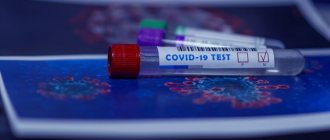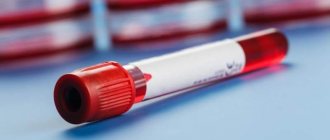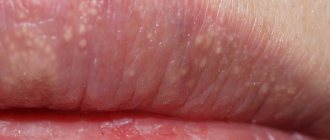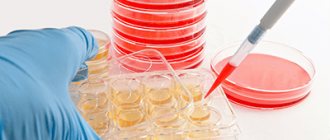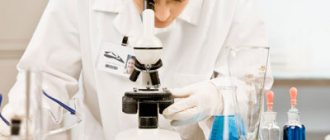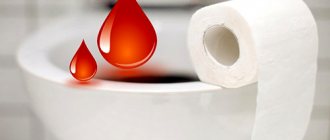A test for occult blood in stool is prescribed if occult bleeding is suspected. Normally, 1 g of feces of a healthy person contains no more than 2 mg of hemoglobin, that is, less than 2 ml of blood is released with feces during the day. With significant gastrointestinal bleeding, the color of the stool changes.
When the source of bleeding is highly localized (stomach, duodenum, small intestine), they become dark, tarry in color (melena), and when low, blood in the stool is detected visually. If blood is present in the stool, but is not detected either visually or during microscopy, it is called hidden, and bleeding, accordingly, hidden. It can be detected by laboratory methods of analyzing stool for occult blood:
- test with benzidine (Gregersen reaction) or guaiac resin;
- quantitative immunochemical method.
The detection of blood in the stool indicates that the patient has diseases of the stomach or intestines that occur with a violation of the integrity of their mucous membrane.
Causes of blood in stool
The main reason for ordering an analysis is a suspicion of intestinal cancer, or any of its parts. After all, very often the onset of a terrible disease passes without obvious symptoms or bleeding.
The presence of blood cannot be seen, not only visually, but even with a microscopic examination.
At the very beginning, the malignant tumor is so small that the passage of stool causes little injury. Very little blood is secreted; in the intestines it is subjected to the action of enzymes, as a result of which red blood cells and hemoglobin become colorless, lose their characteristic red tint, and are invisible during emptying. It is impossible to determine them except by using special chemical reagents. Chemical reactions turn red blood cells into bright colors.
In addition, the test shows positive results in the following cases:
- formation of polyps in the intestines;
- inflammation that destroys the walls of the digestive tract;
- chronic diseases of any part of the gastrointestinal tract;
- ulcerative colitis or erosions in the intestinal ducts;
- pathologies of the colon, chronic inflammatory processes of the mucous membrane;
- diverticulosis.
A false positive result during a stool occult blood test can even cause bleeding gums.
It may also be useful for you to know: How to take a stool test for coprogram?
What kind of research is this and what is it for?
Compared to instrumental methods, it is completely harmless and painless. But nevertheless, it is very effective, it allows you to finally confirm the correct diagnosis and begin treatment of a cancerous tumor at the earliest stages of its development, thereby saving the patient’s life.
Therefore, it is necessary to treat it with full responsibility and in no case ignore the doctor’s prescription.
Typically, patients complain of the following symptoms:
- painful sensations, bloating, gas formation that occurs after defecation;
- problems with bowel movements, constipation or diarrhea, pain when going to the toilet, a feeling that he has not cleared the stool;
- there is blood, mucus, foam in the stool;
- weight drops sharply, you don’t want to eat;
- body temperature rises, accompanied by chills, nausea, and often vomit;
- other digestive tract problems.
A stool occult blood test should be performed after the age of forty for absolutely everyone for safety purposes and early diagnosis of cancer cells in the colon or duodenum.
It is also given if the general analysis does not reveal blood, and the presumptive diagnosis indicates the opposite.
When is a referral for analysis issued?
In addition to screening the age group over forty years, the doctor writes a referral for this test in the following cases:
|
The analysis reveals the slightest damage to the walls of the intestine. If an admixture of blood higher than normal is detected in the stool, the test is repeated and, if the result is confirmed, the patient is sent to see a proctologist or gastroenterologist.
How to test for occult blood in stool
Modern diagnostic centers carry out such diagnostics using two methods:
- The Gregersen reaction or benzidine test requires special preparation, which includes a diet without meat, since chemical reagents determine the red blood cells of not only humans, but also animals. Examination of stool using this method makes it possible to determine hidden bleeding in any part of the gastrointestinal tract.
- Analysis of feces for occult blood using the immunochemical method is the most modern, does not require limiting foods containing iron and meat; reagents determine only human hemoglobin. Prescribed to clarify pathologies of the lower part of the digestive tract. But it is not very informative for the stomach and esophagus.
Sometimes laboratories use azopyram tests to detect high levels of red blood cells in stool or urine.
The laboratory test method is selected by the attending physician based on the patient’s medical history and complaints.
When you shouldn't worry
There is no need to worry when detecting red substances only in rare cases.
- The first is if the day before you consumed tomatoes, beets, spicy dishes with red peppers, pomegranate juice, blueberries, currants and other coloring foods, baked goods and drinks with red food coloring.
- The second is taking medications prescribed by a doctor, who indicated the possible appearance of blood in the stool. These are some antibiotics, anti-inflammatory medications, drugs containing potassium and iron.
If one of these cases is yours, but the symptom does not go away after a while, you need to consult a doctor.
Where to do
A stool test for occult blood can be taken at a local clinic or at paid diagnostic centers.
Depending on the choice of method, its cost ranges from 350 to 700 rubles.
A rapid analysis to detect hidden bleeding can be carried out at home. To do this, any pharmacy sells a special test that works using the immunochromatographic method and allows you to immediately detect the presence of blood in the stool.
Methodology for conducting analysis yourself:
- Buys a test at a pharmacy.
- We open it, take out a special spatula and a container with a chemical reagent.
- We collect the feces in a container, as written in the instructions.
- Place a few drops of the resulting mixture onto the indicator.
- You need to wait a bit for the result to finish.
- With almost 100% probability, two test strips show a positive result. This means that you need to visit the doctor.
After 40 years, such a test must be carried out at least once every two years, and after fifty - once a year.
Alarming symptoms
Bleeding from the anus is an alarming symptom, which is often caused by damage to the integrity of the walls of the vessels of the digestive tract or diseases affecting the anal area (anal canal and anus). The appearance of blood inclusions in the stool can serve as a sign of diseases that do not threaten the life and general health of a person or indicate the development of dangerous pathologies that require immediate medical attention.
In some cases, the presence of reddish inclusions in the stool or complete coloring of the stool in red or black appears after eating certain foods that contain natural or artificial food colors. Such products include:
- red beet dishes (first courses, salads, juice);
- raw red bell pepper;
- brightly colored berries, especially currants;
- blood sausage and other blood dishes;
- tomatoes, as well as sauces prepared on their basis, first and second courses, tomato juice;
- factory-made desserts and jellies colored with artificial colors;
- bright carbonated drinks.
If there are no prerequisites to suspect a disease of the gastrointestinal tract (gastrointestinal tract), you should not panic if you notice reddish streaks or inclusions in the stool; first of all, you need to remember what foods were included in the diet over the last 2-4 days.
Causes
If blood inclusions appear in the stool or bleeding from the anus develops, you cannot treat it yourself at home; you must consult a doctor to establish an accurate diagnosis and prescribe appropriate treatment. Even the mildest diseases, accompanied by the appearance of blood in the stool, can progress over time, become complicated and transform into more severe pathologies, including malignant neoplasms.
Preparing for analysis
The immunochemical method excludes diet, so you can eat anything. But within 14 days, give up:
- any laxative drugs;
- medications such as Aspirin or Ibuprofen that affect blood clotting and cause bleeding;
- instrumental diagnostic methods such as colonoscopy or irrigoscopy, which can change the intestinal mucous membranes. This also includes enemas and rectal suppositories.
Gregersen's reaction requires more careful preparation . Otherwise, you can get a false positive result, since the reagents are sensitive to animal hemoglobin, some vitamins and other substances contained in food.
Many patients are interested in the question of how long they need to prepare for this procedure and how to do it.
Preparation for the study begins 3-4 days in advance and includes:
- diet;
- complete refusal of medications that contain bismuth, iron-containing components, ascorbic acid, acetylsalicylic acid and barium;
- postponing instrumental diagnostics of the intestine for several days after the test. It is prohibited to perform a colonoscopy or x-ray the day before;
- exclusion of rectal suppositories and enemas;
- refusal to brush your teeth and visit the dentist, since blood from bleeding gums during the treatment period can enter the gastrointestinal tract and give a false result.
Note!
During the menstrual cycle, women are not allowed to test their stool for occult blood.
Prohibited Products
What you cannot eat and should be excluded from your diet 4 days before the test:
- meat and offal, including liver;
- fish dishes;
- sausages, ham;
- apples in any form, especially green;
- plums, bananas, pineapples;
- from vegetables - tomatoes, carrots, beets, bell peppers, cucumbers, cabbage of any variety, zucchini;
- dishes made from foods containing large amounts of iron, as well as blueberries, pomegranates, and white beans.
- paprika, any fresh herbs, horseradish, nuts.
What you can eat:
- eggs in any form;
- porridge;
- potato;
- bakery products;
- oil, including butter;
- fruit, but not too much;
- dairy and fermented milk products.
Folk remedies
Positive occult blood in the stool means that a person needs to undergo a full examination to determine its cause and begin treatment. In complex therapy, you can use recipes from witch doctors and healers, but strictly after making an accurate diagnosis.
It is necessary to consult with a proctologist to select effective methods, taking into account the state of health and the individual characteristics of the body.
| Name | Recipe | Application |
| Baths | Brew 2 tbsp boiling water. pharmaceutical chamomile. Infuse the resulting mixture and strain. | Baths are recommended for hemorrhoids. Water procedures take 20-30 minutes. |
| Nettle | Dry leaves of the plant are poured with boiling water, infused and filtered | It is recommended to take the finished product 3 times a day. Nettle stops bleeding well. |
| St. John's wort | The herb (15 g) must be brewed in a thermos with hot water (250 ml). The resulting mixture should be infused overnight. In the morning, strain the medicine and dilute with warm boiled water to obtain 200 ml. | It is recommended to take the finished product orally before meals, 3 times a day, 25 ml. The course of treatment lasts 14 days. |
| Herbal collection | Mix 2 tsp. yarrow and calendula 5 tbsp. Add 3 tbsp. chamomile and clover, also 7 tbsp. cudweed and birch leaves. Pour boiling water (0.5 tbsp) into 1 tbsp. herbal collection. Infuse, cool and strain. | It is recommended to take the finished decoction an hour after meals 3 times a day. |
| Slippery elm bark | Pour 0.5 tsp. powder with hot water (1 tbsp.). Add 1 tsp. simple or granular bark. Place the resulting mass on medium heat and heat for an additional 20 minutes. Cool and strain well. | It is recommended to take the finished medicine orally, 1-3 tbsp. every day. |
| Healing infusion | Mix chopped dill and rose hips in equal proportions. Add stinging nettle, chamomile flowers and motherwort. Pour 1 tbsp. the resulting mass with boiling water (200 ml). It is better to infuse all components in a thermos for 1.5 hours. Strain the broth and take it orally. | It is recommended to use the finished product in the morning and evening, 0.5 tbsp. The course of therapy lasts a month. |
For internal bleeding, it is also recommended to use a decoction of orange peels. Onion infusion has a bactericidal and anti-inflammatory effect against parasitic infections.
Early diagnosis of occult blood in human feces will make it possible to identify pathological processes in the first stages of development. Also conduct additional examination and begin treatment, which will help prevent possible complications.
In most cases, positive stool test results are accompanied by characteristic symptoms. This means that the patient must begin treatment. Otherwise, he will face serious consequences.
How to get tested correctly
The accuracy of any method depends not only on preparation, but also on how correctly the feces are collected. When collecting material, you should avoid impurities in the form of droplets of water or urine, vaginal discharge, drug residues, suppositories, laxatives, etc.
You should purchase a plastic, disposable, sterile container with a tight-fitting lid from the pharmacy. It is equipped with a special spatula
How to collect stool yourself:
- You cannot urinate into the toilet, so take care of a special container in advance;
- take, for example, a pot, wash thoroughly with soap or other antibacterial cleaning agent, rinse several times with running water, treat with boiling water;
- the process of defecation should not be accompanied by the release of urine, so first empty your bladder;
- feces for analysis must be obtained naturally. You cannot give enemas or take laxatives;
- After defecating in the pot, use a spatula to separate at least a teaspoon of feces and transfer it to a special container. The mass should not occupy more than a third of its volume;
- for more accurate results, you can make several samples of feces from different parts of the feces into different containers;
- Screw it tightly, attach the direction and take it to the laboratory.
How to submit:
- You must bring fresh stool to the laboratory; its shelf life is no more than 3 hours ;
- you can still store it on the refrigerator shelf , but then you will have to deliver the biomaterial, covered with ice cubes, and urgently by taxi;
- Frozen or preserved biomaterial is not suitable for diagnostics.
The response time depends on the laboratory you contacted and ranges from three to six days.
Collection of stool for research
Even careful preparation will be completely useless if the biological material is collected incorrectly.
There are special containers for transporting feces to the laboratory - they are sterile and guarantee the biological purity of the collected excrement
How to pass feces correctly? To obtain material suitable for research, you must follow the following recommendations:
- A sterile container must be used to collect excrement. It can be purchased at any pharmacy. The set includes a jar with a lid and a special spoon.
- First you need to empty your bladder. Then place an oilcloth in the toilet.
- After bowel movements, it is necessary to take three portions of feces from different places.
The material must be delivered to the laboratory within the next three hours. It cannot be stored.
Interpretation of results: norm and possible diseases
A negative result is normal for the human body. But it does not always carry informative accuracy and indicates that there is no internal bleeding in the gastrointestinal tract. In this case, repeat tests are usually prescribed.
A positive result indicates an excess of blood in the stool, the norm of which is no more than 2 mg of hemoglobin per 1 g of biomaterial.
The intensity of chemical reactions is expressed from one to four pluses. One is a weakly positive result, the rest are positive.
Gregersen test is positive - what does this mean:
- malignant formations in any part of the gastrointestinal tract;
- the presence of polyps and erosion;
- exacerbation of ulcers;
- hemorrhoids;
- varicose veins in the digestive tract;
- intestinal tuberculosis;
- Crohn's disease.
The source of the discharge needs to be determined additionally.
Note!
The presence of hidden blood in the stool does not always indicate pathologies of the digestive organs.
False results
If the patient did not follow a strict diet when he was prescribed the Gregersen method, then most often the test result is false positive, as in the following cases:
- nosebleeds;
- menstruation;
- bleeding gums;
- helminthiasis;
- diseases of the hematopoietic organs.
In a newborn baby, a false positive reaction is often associated with the presence of allergic reactions and constipation.
What does deciphering the results of the immunochemical method say?
The answer to the question will be a hemoglobin content of more than 50 ng/ml. This means inflammatory processes in any part of the intestine, damaging the walls of the mucous membrane. At this moment, a large number of red blood cells are present in the blood. Can mean:
- chronic diseases of any part of the gastrointestinal tract, called Crohn's disease;
- malignant processes in the large intestine;
- hemorrhoids;
- ulcerative inflammation of the large intestine
Fecal occult blood analysis is considered a fairly informative method, but despite this, it is often false positive or false negative. This depends on many factors, which an experienced doctor will definitely take into account. He will prescribe a repeat test, or even better, conduct a colonoscopy, which will most likely help confirm or refute the preliminary diagnosis.
Decoding indicators
After the reaction, the laboratory technician evaluates the result of the occult blood test. The analysis is carried out quickly and answers can be provided within the current day, so the method is a rapid diagnosis.
Negative test - no blood detected
If after the test the reagent does not change color, then the reaction is considered negative. If the patient has clinical manifestations, it is recommended to repeat the test three times.
The test has its own error and cannot accurately determine the absence of bleeding. The attending physician may prescribe an in-depth examination if in doubt.
Positive test - blood is present
If the result is positive, the reagent changes color. In this case, it is necessary to determine the source of bleeding. The reaction is only a marker; it determines the fact of damage; it is necessary to determine its location.



